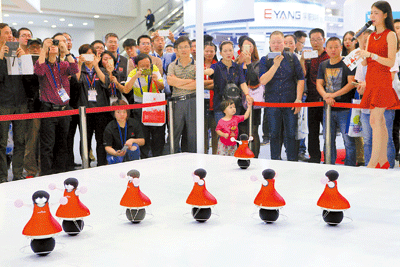
Liu Minxia
mllmx@msn.com
THE China Hi-Tech Fair that opened in Shenzhen yesterday has a section for countries on the route of China’s “Belt and Road” initiative for the first time, in a bid to promote technology exchanges.
Twenty-one countries, including Pakistan, Bulgaria, Russia and Malaysia, formed 29 exhibition groups showcasing new business ideas, high-tech facilities or time-honored products at the fair.
Many of them are joining the fair for the first time, according to the organizer of the fair.
Led by Lyudmila Ogorodova, Russia’s deputy minister of education and science, the Russian exhibition group highlights more than 30 high-tech firms, colleges and research institutes. The exhibition area of the Russian group tripled from last year to more than 200 square meters.
“We are looking for Chinese clients here,” said Helen Kamenskaya, an engineer with ABBYY, a Russia software company that provides optical character recognition.
More than a dozen Kenyan businessmen and government officials are seeking Shenzhen investors for their “Silicon Valley of Africa” project. The country’s minister of information and communication, Fred Matiang’i, will give a speech during a forum.
Katya Staykova, director of public relations of the Bulgarian-Chinese Business Development Association, greeted visitors with a smile.
Staykova presented a blueprint for an economic zone on the route of the “Belt and Road” initiative that will link Asia with Europe.
The Euro-Chinese Economic Development Zone, a project based in Plovdiv, Bulgaria, is gaining the attention of Chinese investors thanks to its adjacency to six European ports, according to Staykova.
“Bulgaria is the door to Europe and the economic zone is a hub on the ‘Belt and Road.’ We are planning a logistics center and a high-tech center,” said Zhang Changqing, general manager of the zone.
(Continued on P3)
(More on P2)
“Mayor Xu Qin led a delegation to visit the zone earlier this year and we hope more Shenzhen businessmen sharing the same vision can collaborate with us.”
Jahanzaib Shafi, an official with Pakistan’s ministry of information technology, led five information technology companies to the fair, seeking investors.
“Exports of Pakistani IT products have been growing steadily, even during the global financial crisis in 2008 and 2009,” said Shafi. “Big Shenzhen companies like ZTE Corp. and Huawei Technologies are establishing themselves in our country and Pakistani companies are developing here too.”
“The One Belt One Road initiative offers big chances to countries involved, especially in terms of technology exchanges,” said Ales Cervinka, director of CzechTrade, a Czech trade promotion agency.
China’s “One belt, One road” initiative aims to establish new routes linking Asia, Europe and Africa. It has two parts -- a new “Silk Road economic belt” linking China to Europe that cuts through mountainous regions in Central Asia; and the “maritime Silk Road” that links China’s port facilities with the African coast and than pushes up through the Suez Canal into the Mediterranean Sea.
The “belt and road” concept is still in the planning stages and the routes will require logistics hubs, communication networks, airports, railway lines, modern highways, ports and a military component that allows for a rapid response to a crisis.
|

